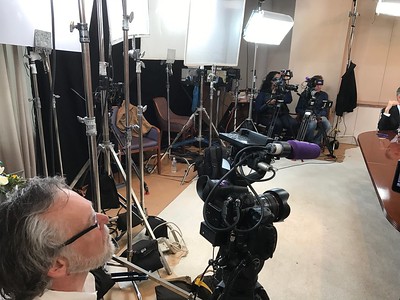Adding an interview camera is just one way to make your video more interesting.
Developments in digital videography have made filming with multiple cameras easier and cheaper than ever. What are the advantages of using one, two, or even three cameras to film an interview for your video production?
One camera
The most basic and least costly approach to filming an interview is obviously … one camera. Usually in this scenario, the single camera is focused on the interviewee, who’s looking offscreen at an unseen interviewer. The advantage of using a single camera is it’s simplicity. There’s just much less to worry about. The setup is quicker. There’s less background to light and fewer props are needed. You only need to budget for one camera and operator. The single camera angle is really all you need if you have plenty of other images to intercut with the interview. But that’s not always the case. Sometimes you really need and want more for your video production.
Before moving on from the single-cam option, there’s very useful two-for-one deal that’s worth considering. It involves filming at a higher resolution than what you’ll be editing in. A typical scenario is shooting in 4K (or UHD) and posting in HD. The 4K image is four times the size of HD resolution so you can either use the entire 4K image or “punch in” to use some tighter portion of it. You get multiple framings for the price of one.
Two cameras
The two-camera set up comes in two flavors: both cameras film the interviewee, but at different angles (typically a medium wide shot and a closeup) or one camera focuses on the interviewee and the other on the interviewer. In either case, you’ll have more flexibility when you edit the interview. But your camera budget will possibly double and the set up will be a bit more complicated. You’ll need extra time, and gear, to frame your shots and make sure you don’t see any lighting stands or other grip equipment in the picture. Filming with two cameras is a great option when you don’t have other images to add in.
Three (or more) cameras
Think about a larger production if:
-
- the interviewer is to be included in the scene
- the interview is the prominent element in the finished production, if not the sole element
- the interviewee is him or herself prominent and is deserving of the added attention
- multiple people being interviewed at the same time and the additional cameras are being used to isolate on individual speakers
All of these are very good reasons to use three or more cameras, and they will add significant production value. They’ll add cost and time, too!




